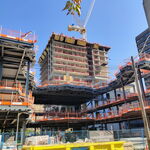JSF-1
Active Member
New video this week, looking at the 514 CHERRY Streetcar.
They "created" rules, laws, and procedures for the streetcar for the "safety" of all. Unfortunately, in doing so, they effectively slowed the streetcar down to a crawl. Do the buses follow the same rules? Very unlikely it seems. Many procedures where put in "temporarily", until a problem is fixed, but the problem never seems to be fixed. The old stopping at each track switch is one such example. They keep deferring the fixes because it is not in the budget.I recently began riding the streetcar again, and was sort of surprised how much it felt like it did, pre-pandemic. It sucked.
At a green light, it would accelerate for a moment, then stop for no apparent reason, before slowly lumbering through an intersection with no turns/switches, and not even an oncoming streetcar. On straightaways, it travelled well below the speed limit, and seemed to invent reasons to randomly slow, stop, and plod.
It was comically deferential to cars and kept slowing to allow them to pass.
None of this is new, but after over a year of doing most of my trips on foot and bike, my perspective is.
Does anyone think we will we ever ride streetcars that move quickly, decisively, not slowing to to 5 km/h through intersections and turns, etc?
Will there be a TTC CEO who supports streetcars as a surface transit solution, and who fights TTS harder for streetcar priority, unlike the current disappointment from Boston?
Probably ahead of schedule.I recently began riding the streetcar again, and was sort of surprised how much it felt like it did, pre-pandemic. It sucked.
At a green light, it would accelerate for a moment, then stop for no apparent reason ...
Unfortunately, it was not ahead of schedule. I have seen this stopping at intersections behaviour worsening over the past few years, all part of the supposed safety rules I assume.Probably ahead of schedule.
Though in many ways, this is an improvement, as they seem to be trying hard not to create bunching and 20-minute gaps when traffic/ridership is lower than expected.
I've not seen it all at intersections (where there's no other tracks), except when they are trying to stay on time.Unfortunately, it was not ahead of schedule. I have seen this stopping at intersections behaviour worsening over the past few years, all part of the supposed safety rules I assume.
The close stops are generally the result of the NIMBYs. Ditto for the removal of closely stopped bus and streetcars stops, the NIMBYs continue to protest improvements to this day. They'll accept the removal of stops, but not in their neighbourhood.The TTC does a dandy job destroying the usefulness of streetcars. Perhaps if we thought of them as LRTs and make them a rapid service vehicles then things would improve. For example, Spadina/Harbourfront and St. Clair are on ROWs and could be made into proper LRTs yet they are just as slow as the non-ROW lines. Yes traffic signals is part of it but the insanely close stop spacing don't help matters. Its as if the TTC and the city don't want streetcars to succeed. It's also a reason why folks like Ford want things underground because it's the only system we have that runs moderately fast. Why can't the TTC run the streetcars like a true LRT? Especially on lines with dedicated ROW. Forced slow orders on intersections and loops/switches and other random things cause the streetcar to be a bottleneck than a form of transportation. It's faster to get around on bikes and cars than to ride them.
It's a balancing act and complicated by placement of traffic lights etc. Stops that are 'too close' obviously slow down the service but stops too far apart will make them almost inaccessible for many potential customers. The City also now tries to put stops at controlled crossings to avoid people being run over going to/from the bus or streetcar. Yes, there are NIMBYs on both sides but overall I think the City and TTC do a fairly good job of balancing the competing priorities.Exactly. It shows the city's lack of planning leadership. It's fine to consult but often the city gets bogged down by a small and vocal minority that want stops at each corner. The city fails at looking at a broader picture of speed of service, not just frequency.
I get the same thing from Australia folks, but you are doing 2 different style of track construction. TTC is looking at 50-75 years for the base with rail about 20-30 years compare to others who only go down to the roadbed about every 20-40 years. When TTC needs to replace rails, its a matter of a few days. Intersections on the other hand can be a month.While it takes forever to replace streetcar tracks in Toronto, it takes a weekend to do so in Zurich.
Except that in Toronto, the Willcocks and Sussex intersections will not give true transit priority to the 100+ people on board the streetcars, but will to the single-occupant motor vehicle making a left turn.It is a balancing act but the city gets it wrong most of the time in my opinion. Take just one example of Spadina - There number of stops on the 510 between College and Bloor. It’s a distance of 1km. It has 4 stops: College, Willcocks, Harbord, Sussex. That’s an average distance of 250m. Way too close. Willcocks and Sussex can and should be removed as Harbord is a short walk from both. Yes it means a few passengers will have a slightly longer walk to their stop but the speed improves by not having the vehicle stop so many times and being caught up in traffic lights. This is just one example.




